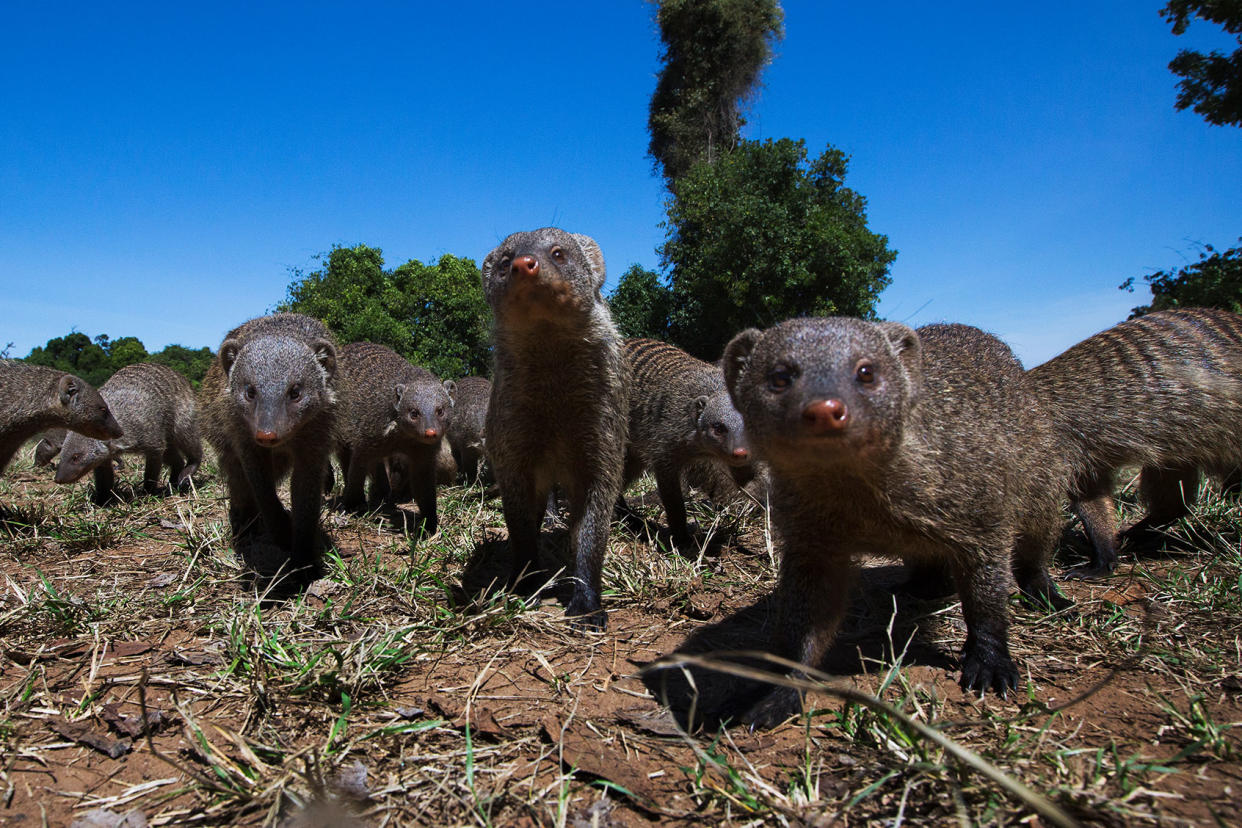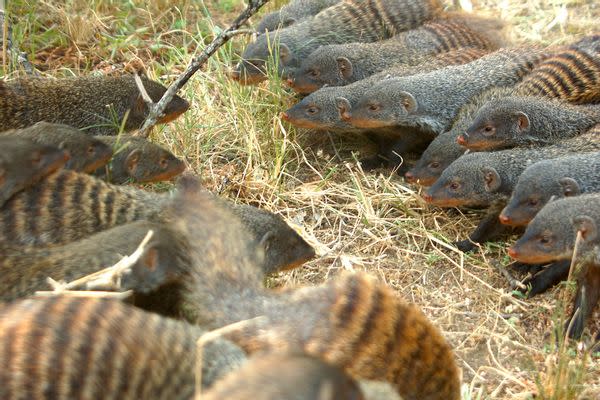Mongeese are some of the only animals that go to war. Scientists could soon find out why

She’s the authoritarian matriarchal warlord with a fart so powerful it strikes terror in the heart of honey badgers. She rolls with a posse that’s 30-strong, uses warthogs like DoorDash for her tick snacks between brawls, and has a cousin who catches birds with his butt cheeks. Her ancestors were sailing to Madagascar more than 65 million years before the British Empire, and she gets turned on by the hyper-violence of gang fights. Exalted with mummification in ancient Egypt, she’s the Rikki-Tikki Riot Grrl of the east African plains, the erotically berserk mob tactician that turns cobras into ballpark brats on the daily. If you can see her coming, it’s already too late. Nothing can stop the battle-hardened banded mongoose.
And in case you missed the news, self-organized mongoose warfare has become so brutally hardcore that the call of scientific inquiry has rung out across the globe, seeking to make sense of (or at least seek safety from) the species’ ceaseless fury. And that call has been answered. An elite and seemingly fearless international crew of mongoose-minded researchers are now setting out to figure out how these thrash-metal freak weasels are capable of such merciless violence between their warring tribes — and what we humans might learn about our own war-party tendencies from the aggressive behavior of these vicious mammals.
Lighting beacons of hope from their home universities of Cambridge, York, Swansea and Bielefeld, Germany — the scientific fellowship will gather under the lead of Professor Michael Cant of the University of Exeter, and travel to the heart of Africa under the auspices of a $3.2 million grant. On a mission that can only be described as either unflinchingly courageous or lethally naïve, the team will rendezvous with an expert field team of brave Ugandan scientists currently at the front of the seemingly unstoppable mongoose madness.
From a clandestine perch, the academics will conduct mongoose reconnaissance to analyze the desert hellcats’ rampage tactics at a safe remove, trying to understand how the forces of evolution can culminate to create one particular species with a taste for actual warfare and extreme violence. And to presumably do the only thing we humans can when faced with such unstoppable lawlessness — figure out what it takes exactly to make the wild bandit hordes call a truce and end their reigns of terror.

“An outstanding problem in evolutionary biology is to explain how cooperative groups evolve by natural selection,” Cant said in a release from the Centre for Ecology and Conservation at Exeter. “Classic research on this question has shown that factors that operate within the group, such as kinship and reciprocity, can select for altruism. Yet there is now substantial evidence from humans and other social animals that conflict between groups – or warfare – can also exert a profound influence on social behavior.”
Thankfully, the mongoose rampage isn’t targeting humans, though they aren’t above ground-based kitchen invasions when pushed into an environmental threat, and their toxic bites can quickly become lethal.
This isn’t Cant’s first tour of duty, though. He’s the head of Exeter’s long-term Banded Mongoose Research Project and his previous attempts to understand bloodthirsty mongoose warfare led him to Uganda before, where he witnessed an extremist mongoose beheading in the wild. He lured one mongoose mob out of its hideout by smearing an enemy gang’s feces on the property then blasting a rival gang’s fight-taunts out of a Bluetooth speaker. Presumably ready to mount-up and roll hard, the mob came out to find crap on their doorstep — and that’s when Cant launched a drone-camera to capture the action.
Want more health and science stories in your inbox? Subscribe to Salon's weekly newsletter Lab Notes.
Cant was right to keep his distance. All the unchecked rage in their five-pound, furry bodies seems too powerful — suggesting that instead of having brain cells, the creatures just have an endlessly looping, full-volume mix of the screaming mid-bridge wax-rips of The Beastie Boys’ “Sabotage.” Because when mongoose mobs wake up and choose violence, they don’t just choose it once — they choose it over and over again. Hammering neighboring gangs mercilessly for what scientists say can amount to four vicious terroristic assaults a day, the resulting territorial scatterplot of bloodbaths makes the final season of the Sopranos look like an episode of Paw Patrol.
And it gets even more intense somehow. These things are the Amazonian Klingons of ground mammals. Their female generals lead troops of between 6 and 40 of these little berserker weasels into battle with a plan of attack coordinated beside grizzly mongoose war veterans. They send their males to form a quasi-Roman-phalanx position around an enemy gang in an attack so unhinged that the females become wild with battle lust. Claws akimbo and fully disrespectful, the ladies will straight-up just start mating with enemy males — right then and there — while their own dudes are mid-scrap. They’re often witnessed bailing on their own brawls to get down on a gang-war breeding frenzy that has only made their diverse gene pools more unstoppable.
The theory so far is that the female generals have bawdy motives when they go to war in the first place.
“But covert mating isn't the only casus belli. When they looked more closely at their records, the researchers discovered that 417 of the 579 wars didn't involve females in oestrus [heat]. These appear to be more about status, territory, resources – and genocide,” New Scientist author Graham Lawton wrote last year.
These matriarchal battle queens are scandalous too. They synchronize all their tribe’s pup births to happen at once, so nobody ever figures out whose daddy is whose. Then they participate in some collective radical childcare and enlist grandparents to babysit while they ride back off to the battlefield, presumably seeking the glory of Valhalla.
https://twitter.com/CantMichael/status/1676193503108386816
“Intergroup conflict could in principle act as a fundamental molding force in the evolution of animal societies, shaping not just behavior but also life history and social organization, but this idea has not been tested. We will test this hypothesis through an integrated theory, field and lab study using two animal societies as model systems,” Cant said. “The outcome will be a significant advance in our understanding of how social life forms and societies evolve.”
An earlier version of this article originally appeared in Salon's Lab Notes, a weekly newsletter from our Science & Health team.

